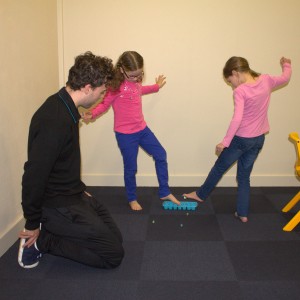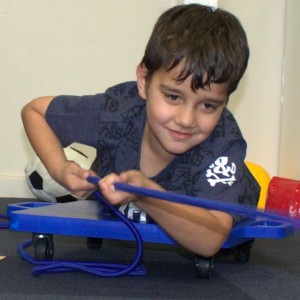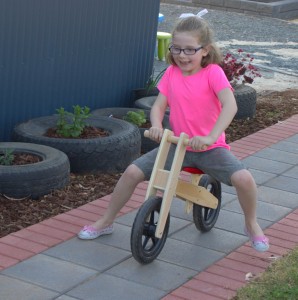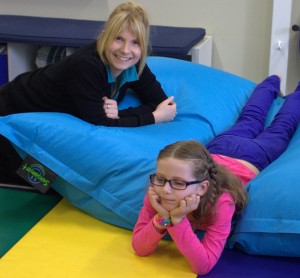 Most people know about the five senses, sight, hearing, touch, smell, and taste but we also have senses that tell us about movement, balance and pressure.
Most people know about the five senses, sight, hearing, touch, smell, and taste but we also have senses that tell us about movement, balance and pressure.
Some children have difficulty processing the information from their senses. They may be under-sensitive and seek out extra stimulation or over-sensitive and avoid stimulation. Providing opportunities to experience sensations can help children learn to process information more accurately and efficiently.
If children have difficulty processing sensory information occupational therapists can help by assessing children's sensory processing and providing ideas and activities to help regulate a child's sensory system. Here are some ideas that may help:
 Vision
Vision
Our eyes detect changes in light. This gives us information about edges, lines, colour, movement, depth, shape, size, and space between objects and people. We also need to remember, organise, recognise and use visual information.
Here are some activities to help children developing visual processing skills.
- Puzzles and ‘I Spy’ games
- Search and find activities such as ‘Where’s Wally?’
- Spot the difference pictures
- Reading books
- Guess Who? and Connect 4
- Treasure hunts, memory cards, tangram shape puzzles
- Sequencing patterns of shapes, toys or coloured objects
- Catching and throwing
- Mazes
- Dot-to-dot puzzles
Sound
Children who are sensitive to sound may seem to ‘zone out’, to reduce their responsiveness to unpleasant sound and may not initially respond when spoken to. Some children need more sounds to keep themselves alert and engaged. They may enjoying tipping things out of boxes, banging things together, clapping, teeth chattering, talking to themselves or humming.
Some activities to help with processing of sound include:
- Using headphones to play music
- Singing
- Playing musical instruments
- Playing word games like “I went to the beach and I took a …”
- Listening to stories on tape
 Smell
Smell
Children who are sensitive to smell may feel nauseous in response to smell, refuse foods with certain smells, or may be easily irritated by people’s perfumes. Children who seek smells may sniff their food before eating or attempt to eat non-food objects with particular smells.
Here are some activities to develop awareness of smells:
- Use ‘scratch & sniff’ stickers as rewards
- Play with different scents of shaving cream on a garbage bag attached to a window, table or wall.
- Apply clear children’s scented nail polish to their fingertips to sniff throughout the day.
- Draw with scented pens and textas
- Make and use scented play dough
Touch
Some children avoid touch and do not like to be held or touched. Others seek out touch and so may touch things they shouldn't or be excessively physical with others.
Here are some activities to help children practice processing touch.
- Drawing or writing in different textures such as shaving cream, sand or dirt
- Hiding objects in different textures such as water beads, rice or soy beans
- Water play with cups, straws, spoons or graters. Take turns to pour the water using the objects over each other’s hands and feet
- Place objects in your child’s hands while they are blindfolded and get them to guess what they are
- Colour in a shapes with a vibrating pen
- Massage each other’s hands, arms, body, head, legs and feet with a handheld vibrating massager
- Make finger, hand or foot paintings
- Have a water gun, water balloon or spray bottle fight in the backyard
- Do some cooking and have the child involved in mixing the ingredients with their hands
- Make slime with corn flour and food colouring
To find out more about supporting children with the sense of touch click here.
 Balance
Balance
The vestibular sense, which is input from the inner ear, is our centre for balance. It detects our head position and body movements including up/down, back/forth, and side to side movements. It also provides information about whether we are moving fast, slowly or standing still, and whether objects are moving or still in relation to our body. If this sensory system is ‘under registering’ sensory input it can alter the way we understand our body position and lead us to seek extra vestibular input to help us feel regulated (calm and comfortable).
Below are a number of activities to help develop awareness of balance:
- Get your child to hang upside down on monkey bars
- Complete an obstacle course which could involve climbing, jumping and rolling activities. Use what resources you have available. Encourage your child to run or hop around the course.
- Balance on a wobble board while throwing and catching a beanbag or ball.
- Encourage your child to lie over a gym ball while they push and pulls against your hands. Rock your child on the gym ball while holding on to their legs whilst they lay prone (on tummy) and supine (on back).
- Roll your child up in a blanket while they are lying on the floor, then unroll them.
- Do some trampoline exercises, such as jumping, kneeling, sitting, turning.
- Encourage your child to do some skipping with hoops or ropes or use playground equipment, such as swings and slides. Whilst swinging the child can play target games such as quoits, beanbag toss, or throwing and catching a ball.
- Encourage your child to do some bicycle riding or scooter riding.
- Have your child play “Tarzan” by swinging from a rope on a safe tree.
- Get your child to sit with their feet in the middle of a tyre and bound around it.
To develop your child's awareness of their body in space click here.
Pressure.
Some children seek pressure and this can help children to be calm and focused:
Some ways to provide deep pressure include:
- Firm hugs, and massages throughout the day.
- Moving in between activities such as pretending to walk like an animal such as a bear, cat, frog, rabbit, kangaroo; jumping, dancing or stamping, having a "wheelbarrow".
- Lifting and carrying things around the house such as unpacking the shopping, carrying toys in buckets or boxes and playing with bigger, heavier toys.
- Using hot water bottles, sit and move cushions and changing position often
- Using weighted toys, vests and blankets
- Playing with toys that vibrate, and things to squeeze such as play dough and stress balls
- Throwing small bean bags and balancing them on your hands, head and arms
- Jumping on large bean bags, bouncing on fit balls, having a pillow fight, doing some rough and tumble play,
- Dancing, jumping and clapping to music
- Rolling, squeezing, pushing, pulling and poking playdough, putty or plasticine
 Children who have autism, developmental delays or learning problems may have difficulties with their senses which can have an impact on other areas of their development. To find out how an occupational therapist can help click here.
Children who have autism, developmental delays or learning problems may have difficulties with their senses which can have an impact on other areas of their development. To find out how an occupational therapist can help click here.
If you are concerned about your child's sensory processing skills an occupational therapist is the person to see for advice. Occupational therapist can assess your child's skills and advise you on what to do to help your child's development. For more information about occupational therapy at Talking Matters check Our website.
If you would like an occupational therapy assessment read more here or contact us to book an appointment.
Related Blog Posts
If you liked this post you may also like:
Learning outdoors
Playdough Faces
Playing together 101
All about our senses



